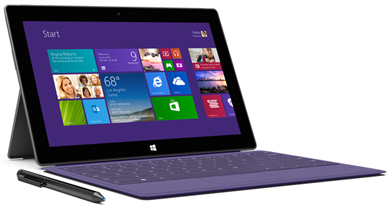News
Microsoft Launches Next-Gen Surface Devices
NEW YORK -- Microsoft unveiled the second-generation of its Surface line of hybrid PC tablets at a launch event Monday.
The new Surface Pro 2 and Surface 2 devices shown Monday come with better speeds, feeds and battery life, as well as a new generation of accessories. Both will be available for pre-order on Tuesday and will be generally available on Oct. 22.
 The Surface Pro 2.
The Surface Pro 2.
The Surface Pro 2 addresses a key objection to the original Surface Pro device. Equipped with Intel's long-awaited Haswell processor, Intel's latest Core i5 CPU, along with engineering to improve power utilization, the new device boasts 75 percent more battery life, according to Surface General Manager Panos Panay.
That promises to be a welcome improvement, considering that some people have complained the Surface Pro only worked for 4 to 5 hours continuously. The battery life boost would enable most workers to use the Surface Pro 2 all day without having to charge it. "It will be the most efficient product to use, and yet it is faster than 95 percent of all laptops and Ultrabooks on the market today," Panay said.
Panay also said that a new accessory called the Power Cover, with an extra battery built into the keyboard pad, would make Surface Pro 2 batteries last 2.5 times longer than Surface Pro batteries. The Power Cover will cost $200 and has a projected availability date in early 2014.
As for the price on the Surface Pro 2, the official Microsoft line of the day was that pricing wasn't a problem for the Surface Pro. "Surface Pro is the best-selling device in its class," Panay said, indicating that all the PCs in use by those in the audience were less powerful and more expensive.
Surface Pro 2 will retail for $899, a figure which does not include a Touch Cover or the Office software that comes standard with the Surface 2.
The new Surface Pro 2 also comes with improved speakers with Dolby processing and 50 percent better graphics performance. The systems processing speed is also 20 percent faster, Panay said. It will come with at least 4 GB of RAM, though some models will include 8 GB. The devices will be available with solid-state drives (SSDs) starting at 64 GB and going as high as 512 GB.
The consumer-focused productivity tablet, the Surface 2, also got a speeds-and-feeds-oriented overhaul, along with a lighter weight. For pricing, Microsoft will start the device at $449, slightly less than pre-launch reports and about $100 more than the price of the current Surface RT model.
Spec improvements include an NVIDIA Tegra 4 processor, a battery life of up to 10 hours for video playback, 1080p video, a USB port upgrade to the 3.0 spec, and camera resolutions at 3.5 megapixels in front and 5 megapixels in the back. In a demo, Panay had the house lights dimmed to show how sensors near the camera kept the lighting on his face consistent for Skype and other videoconferencing software.
The new device is also thinner and lighter than its predecessor, and sports a metallic color and a Surface logo. Both models feature an improved Kickstand, Microsoft's integrated, fold-out hardware for propping the tablet upright on a table or a lap. The previous model provided one 22-degree device angle. The new model kicks out to a second angle, for better screen viewing while being used on a lap or for taller users.
While both new devices are a substantial leap in performance, they're not likely to put a major dent in the market of tablets dominated by the Apple iPad and those running Google Android, said Forrester Research analyst Frank Gillett.
"It's an interesting advance in hardware and software," Gillett said. "The real question is whether developers and end users will give them recognition."
As for the pricing, notably on the Surface 2, Gillett said Microsoft is looking to position Surface as a high-end device. "They are staking out a premium position in the market," he said.
Analyst Jack Gold of J.Gold Associates had a harsher view of the devices. In an e-mail sent to reporters, he said, "They certainly aren't price competitive with all the Android tablets set to come out later this year, including those with the same chips." Gold added, "It doesn't look like Microsoft has done anything which is compelling with these to overcome the negative perceptions."
About the Authors
Scott Bekker is editor in chief of Redmond Channel Partner magazine.
Jeffrey Schwartz is editor of Redmond magazine and also covers cloud computing for Virtualization Review's Cloud Report. In addition, he writes the Channeling the Cloud column for Redmond Channel Partner. Follow him on Twitter @JeffreySchwartz.